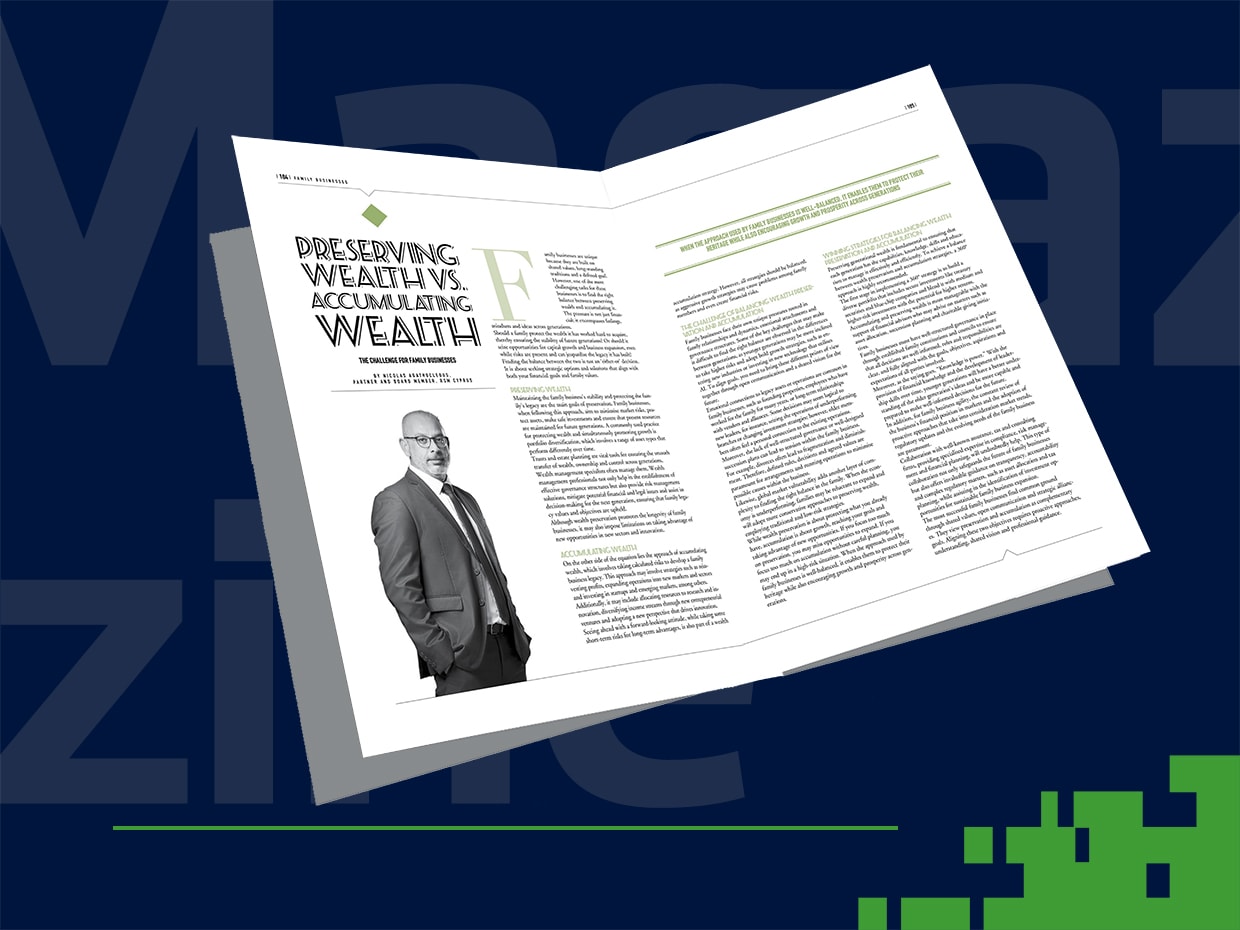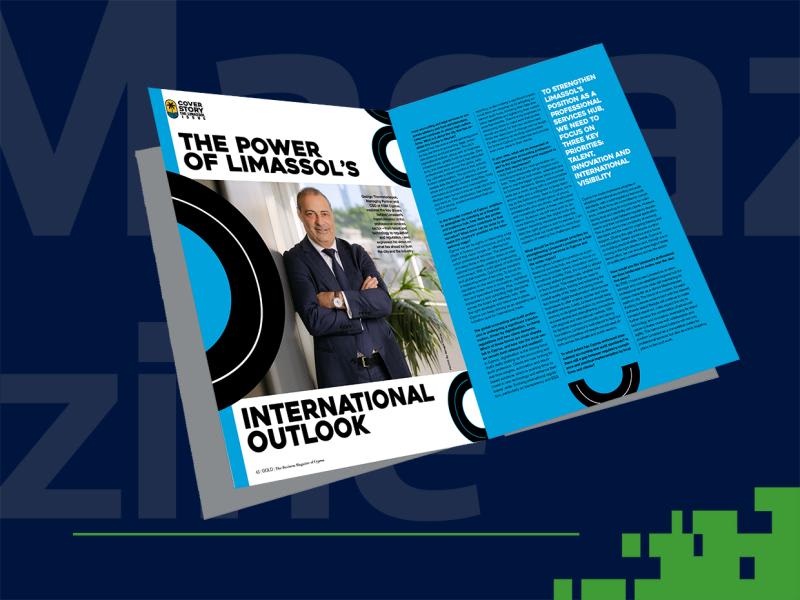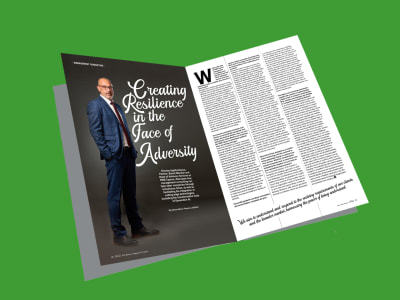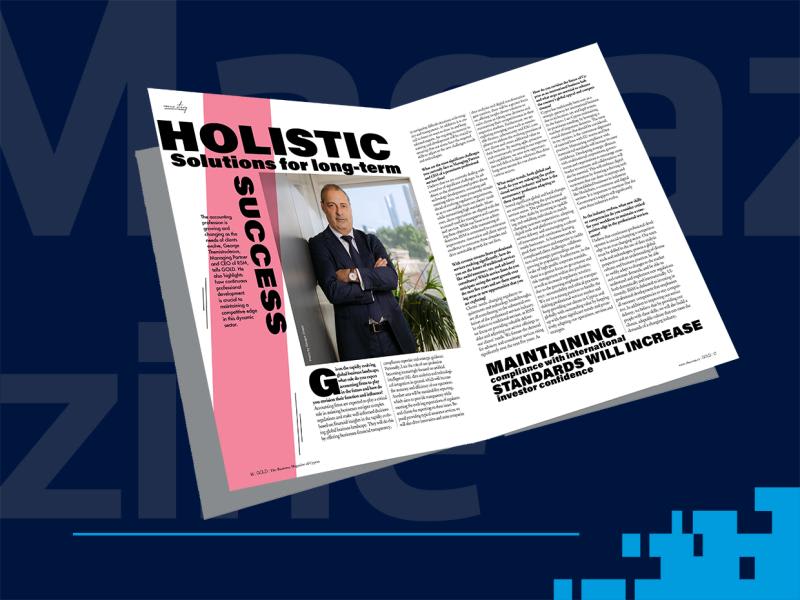An insightful article by Nicolas Agathocleous, Partner and Board Member, RSM Cyprus | Published at the Cyprus Wealth Management 2025 edition.
Family businesses are unique because they are built on shared values, long-standing traditions and a defined goal. However, one of the most challenging tasks for these businesses is to find the right balance between preserving wealth and accumulating it.
The pressure is not just financial; it encompasses feelings, mindsets and ideas across generations.
Should a family protect the wealth it has worked hard to acquire, thereby ensuring the stability of future generations? Or should it seize opportunities for capital growth and business expansion, even while risks are present and can jeopardise the legacy it has built?
Finding the balance between the two is not an 'either-or' decision. It is about seeking strategic options and solutions that align with both your financial goals and family values.

Preserving Wealth
Maintaining the family business's stability and protecting the family's legacy are the main goals of preservation. Family businesses, when following this approach, aim to minimise market risks, protect assets, make safe investments and ensure that present resources are maintained for future generations. A commonly used practice for protecting wealth and simultaneously promoting growth is portfolio diversification, which involves a range of asset types that perform differently over time.
Trusts and estate planning are vital tools for ensuring the smooth transfer of wealth, ownership and control across generations. Wealth management specialists often manage them. Wealth management professionals not only help in the establishment of effective governance structures but also provide risk management solutions, mitigate potential financial and legal issues and assist in decision-making for the next generation, ensuring that family legacy values and objectives are upheld.
Although wealth preservation promotes the longevity of family businesses, it may also impose limitations on taking advantage of new opportunities in new sectors and innovation.
Accumulating Wealth
On the other side of the equation lies the approach of accumulating wealth, which involves taking calculated risks to develop a family business legacy. This approach may involve strategies such as reinvesting profits, expanding operations into new markets and sectors and investing in startups and emerging markets, among others.
Additionally, it may include allocating resources to research and innovation, diversifying income streams through new entrepreneurial ventures and adopting a new perspective that drives innovation.
Seeing ahead with a forward-looking attitude, while taking some short-term risks for long-term advantages, is also part of a wealth accumulation strategy. However, all strategies should be balanced, as aggressive growth strategies may cause problems among family members and even create financial risks.
Well-Balanced Approach

When the approach used by family businesses is well-balanced, it enables them to protect their heritage while also encouraging growth and prosperity across generations.
The challenge of balancing wealth preservation and accumulation
Family businesses face their own unique pressures rooted in family relationships and dynamics, emotional attachments and governance structures. Some of the key challenges that may make it difficult to find the right balance are observed in the differences between generations, as younger generations may be more inclined to take higher risks and adopt bold growth strategies, such as entering new industries or investing in new technology that utilises AI. To align goals, you need to bring these different points of view together through open communication and a shared vision for the future.
Emotional connections to legacy assets or operations are common in family businesses, such as founding properties, employees who have worked for the family for many years, or long-term relationships with vendors and alliances. Some decisions may seem logical to new leaders, for instance, seizing the operations of underperforming branches or changing investment strategies; however, older members often feel a personal connection to the existing operations.
Moreover, the lack of well-structured governance or well-designed succession plans can lead to tension within the family business. For example, divorces often lead to fragmentation and diminishment. Therefore, defined rules, decisions and agreed values are paramount for arrangements and running operations to minimise possible causes within the business.
Likewise, global market vulnerability adds another layer of complexity to finding the right balance in the family. When the economy is underperforming, families may be reluctant to expand and will adopt more conservative approaches to preserving wealth, employing traditional and low-risk strategies.
While wealth preservation is about protecting what you already have, accumulation is about growth, reaching your goals and taking advantage of new opportunities. If you focus too much on preservation, you may miss opportunities to expand. If you focus too much on accumulation without careful planning, you may end up in a high-risk situation. When the approach used by family businesses is well-balanced, it enables them to protect their heritage while also encouraging growth and prosperity across generations.
Winning strategies for balancing wealth preservation and accumulation
Preserving generational wealth is fundamental to ensuring that each generation has the capabilities, knowledge, skills and education to manage it effectively and efficiently. To achieve a balance between wealth preservation and accumulation strategies, a 360° approach is highly recommended.
The first stage in implementing a 360° strategy is to build a diverse portfolio that includes secure investments, such as treasury securities and blue-chip companies, and blend it with medium- and higher-risk investments that have the potential for higher returns.
Accumulating and preserving wealth is more manageable with the support of financial advisors who may advise on matters such as asset allocation, succession planning and charitable giving initiatives.
Family businesses must have well-structured governance in place, through established family constitutions and councils, to ensure that all decisions are well-informed, roles and responsibilities are clear, and fully aligned with the goals, objectives, aspirations, and expectations of all parties involved.
Moreover, as the saying goes, "Knowledge is power." With the provision of financial knowledge and the development of leadership skills over time, younger generations will have a better understanding of the older generation's ideas and be more capable and prepared to make well-informed decisions for the future.
In addition, for family business agility, the constant review of the business's financial position in the market and the adoption of proactive approaches that take into consideration market trends, regulatory updates, and the evolving needs of the family business are paramount.
Collaboration with well-known assurance, tax and consulting firms, providing specialised expertise in compliance, risk management and financial planning, will undoubtedly help. This type of collaboration not only safeguards the future of family businesses but also offers invaluable guidance on transparency, accountability and complex regulatory matters, such as asset allocation and tax planning, while assisting in the identification of investment opportunities for sustainable family business expansion.
The most successful family businesses find common ground through shared values, open communication and strategic alliances. They view preservation and accumulation as complementary goals. Aligning these two objectives requires proactive approaches, understanding, shared vision and professional guidance.





